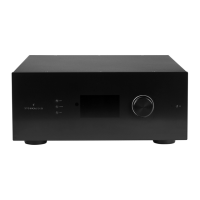
Do you have a question about the StormAudio ISP MK2 and is the answer not in the manual?
| Brand | StormAudio |
|---|---|
| Model | ISP MK2 |
| Category | Amplifier |
| Language | English |
Controls for powering on/off, navigating menus, and viewing unit status.
Adjusting audio volume and muting the output.
Rear panel connections for HDMI, network, and USB devices.
Power connection and main power switch for the unit.
Various input and output connectors for audio and control signals.
Additional output modules and the rear panel cooling fan.
Introduction, package contents, product features, and shipping advice.
Site preparation, ventilation requirements, and power connection.
Network setup and connecting an IR receiver for remote control.
Connecting external audio/video sources and displays.
Initial power-up, startup sequence, and obtaining network IP address.
Default login credentials for system access and security.
Quick access controls and volume adjustment within the web interface.
Accessing system, inputs, main speakers, and settings configurations.
Controls for power, triggers, and exiting the web interface session.
Description of the built-in help feature for understanding UI functions.
Viewing system information, installed modules, and software features.
Managing system configurations, backups, and firmware updates.
Configuring network parameters and managing user access passwords.
Assigning specific setup functions to different user access levels.
Configuring input names, enabling/disabling access, and mapping sources.
Assigning video and audio sources to main theater and zone inputs.
Configuring upmixing, channel trim, audio/video delay, and external device triggers.
Creating a dedicated input for Roon audio streams.
Configuring Roon core and controlling the ISP via the Roon application.
Process of creating and configuring theaters and speaker layouts.
Setting up and managing audio zones for playback.
Creating, saving, and managing custom speaker profiles.
Managing channel activation and custom naming for identification.
Adjusting equalization and delay settings for each channel.
Setting channel levels, applying limiters, and checking signal routing.
Using the tone generator for channel calibration and level matching.
Using the Real-Time Analyzer with a microphone for acoustic response visualization.
Inverting channel polarity and referencing Dirac Live calibration.
Defining signal paths and names for multi-way speaker components.
Configuring crossovers, slopes, and filter types for multi-way speakers.
Setting delay, level, and EQ for individual speaker drivers.
Managing EQ filters, visualizing curves, and creating custom equalization.
Defining filter types, Q factor, gain, and frequency for equalization.
Deleting filters, managing status, selecting channels, and copying EQ settings.
Importing equalization filters from Room EQ Wizard software.
Selecting bass management modes (Standard, Expert, Dirac).
Defining speaker size and how bass frequencies are routed.
Setting crossover frequencies, slopes, and LFE/SUB signal mixing.
Configuring low-pass and subsonic filters for subwoofers.
Adjusting crossover frequencies and slopes for bass management.
Integrating LFE and subwoofer bass into main channels.
Adjusting the tonal balance of the presentation for darker or brighter sound.
Mapping physical analog outputs to different loudspeaker channels.
Setting up secondary child theaters with specific playback and configuration options.
Preparation steps before starting Dirac Live calibration.
Setting up the microphone, initiating calibration, and accessing the software.
Adjusting input gain and output volume levels for accurate calibration.
Measuring the room's acoustic response at different listening positions.
Designing filter responses and selecting bass control modes.
Adjusting crossover frequencies and setting target response curves.
Reviewing corrected response and exporting calculated filters to the ISP.
Saving the new Dirac profile and returning to speaker editing.
Configuring trigger behavior and various system parameters.
HDMI output settings, AV zone delay, and network standby control.
Defining upmixing capabilities and channel mapping for inputs.
Assigning IR remote control functions to inputs and presets.
Defining and managing presets for specific listening scenarios.
Viewing system status, operational data, and signal levels.
Utilizing logging, detailed information, and setting temperature thresholds.
Selecting inputs and adjusting volume via the web UI remote.
Muting, dimming, and selecting presets and audio decoder settings.
Controlling configured triggers directly from the web interface.
Making temporary adjustments to enhance sound and sync.
Selecting and adjusting settings for auxiliary audio zones.
Using the StormRemote app for iOS devices to control the ISP.
Detailed specifications for audio formats, inputs, outputs, and HDMI capabilities.
Specifications for control interfaces, network, and optional modules.
Power supply requirements and physical dimensions of the unit.